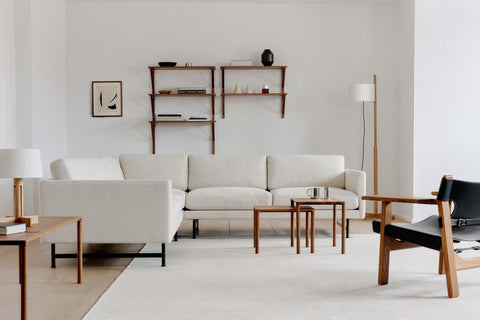Introduction
In recent years, Japandi design has emerged as one of the most captivating trends in interior design, and 2025 is set to be no exception. Combining the clean, functional elegance of Scandinavian design with the minimalism and natural harmony of Japanese aesthetics, Japandi creates spaces that feel both tranquil and sophisticated. As we step into 2025, this design philosophy is more relevant than ever, emphasizing sustainability, craftsmanship, and a return to simplicity in an increasingly complex world. At Habitus, we are proud to offer an exclusive selection of furniture and lighting that perfectly embodies the Japandi ethos. Here’s how you can bring this trend to life in your home with curated pieces from our collection.
What is Japandi Design?
Japandi, a portmanteau of Japanese and Scandinavian, represents the best of both worlds. It’s a fusion of the functional minimalism of Scandinavian interiors with the Zen-inspired tranquility of Japanese design. Key elements include:
Natural Materials : Wood, stone, and other organic materials create warmth and texture.
Neutral Palettes : Soft, muted tones like beige, cream, and grey are accented with darker hues.
Simple Forms : Clean lines and uncluttered spaces ensure harmony and balance.
Functionality : Every piece serves a purpose without sacrificing beauty.
Creating a Japandi-Inspired Living Room
The living room is often the heart of a Japandi home. It should be a space that feels calming yet inviting, blending form and function seamlessly. To achieve this look, consider these key pieces:
Brasilia Lounge Chair by Audo
Designed by Anderssen & Voll in 2022, the Brasilia Lounge Chair by Audo is a beautiful example of a Japandi piece. Its clean lines and natural wood finish evoke Scandinavian simplicity, while its low, grounded form nods to Japanese floor-centric living. Pair it with a soft, neutral-toned throw to enhance its cozy appeal.
Strand Pendant by Muuto
Created by Benjamin Hubert in 2019, the Strand Pendant by Muuto offers the perfect balance of form and function. Its soft, diffused glow creates a warm, welcoming ambiance, while its organic shape complements the natural elements in your space. Hang it above your seating area to tie the room together.
Passage Coffee Table by Audo
Designed by Krøyer-Sætter-Lassen in 2020, the Passage Coffee Table by Audo is a versatile piece that perfectly encapsulates Japandi aesthetics. Crafted from natural oak, its rounded, modular form exudes simplicity and warmth. Use it as a centerpiece to anchor your seating area and complement other minimalist elements in the room.
Cover Lounge Chair by Muuto
Designed by Thomas Bentzen in 2013, the Cover Lounge Chair by Muuto can double as a functional accent piece in a bedroom corner. Its smooth curves and warm wood tones enhance the serene atmosphere of a Japandi-inspired living room or bedroom, making it a perfect spot for quiet reflection. While typically seen as a lounge chair, the Cover Lounge Chair by Muuto can double as a functional accent piece in a bedroom corner. Its smooth curves and warm wood tones enhance the serene atmosphere of a Japandi-inspired bedroom, making it a perfect spot for quiet reflection.
Dining with Japandi Grace
In a Japandi dining room, the focus is on creating a space that feels intimate and functional. Here are some must-have pieces to transform your dining area:
J39 Dining Chair by Børge Mogensen
Often called “The People’s Chair,” the J39 Dining Chair by Fredericia was designed by Børge Mogensen in 1947. Its solid oak frame and hand-woven seat showcase the impeccable craftsmanship that Japandi design values. Pair it with a simple, natural wood dining table (like the linear wood table from Muuto) for a cohesive look.
PH 5 Pendant by Louis Poulsen
Designed by Poul Henningsen in 1958, the PH 5 Pendant is an iconic lighting choice. Its layered structure provides soft, even illumination while eliminating glare. Available in a range of muted tones, this pendant perfectly complements a Japandi-inspired palette.
Linear Dining Table by Muuto
Designed by Thomas Bentzen in 2019, the Linear Dining Table by Muuto exemplifies Japandi’s balance of simplicity and elegance. Its clean lines, sturdy oak construction, and practical design make it a perfect centerpiece for a dining space that emphasizes functionality and style. Pair it with the J39 Dining Chairs for a harmonious look.In a Japandi dining room, the focus is on creating a space that feels intimate and functional.
Japanese Tray by Kristina Dam Studio
The Japanese Tray by Kristina Dam Studio, designed in 2016, is both functional and beautiful, embodying the minimalist aesthetics of Japandi design. Use it to serve tea, display fruits, or as a centerpiece to bring a touch of Japanese culture to your table. No Japandi dining setup is complete without carefully chosen accessories.
Storage Solutions with Style
Storage is an integral part of Japandi interiors, ensuring that spaces remain uncluttered and serene. The focus is on pieces that are as aesthetically pleasing as they are practical.
Royal System by DK3
Designed by Poul Cadovius in 1948, the Royal System by DK3 is a timeless storage solution that exemplifies Japandi’s commitment to functionality and beauty. Its modular design allows for endless customization, making it perfect for displaying books, ceramics, or other treasured items. The natural wood finish adds warmth, while the minimalist design ensures a clean and harmonious look.
No 11 Sideboard by Sibast
Designed by Arne Vodder in 1957, the No 11 Sideboard by Sibast is a timeless piece that embodies Japandi’s dedication to clean lines and functionality. Its sleek wooden frame and ample storage space make it ideal for maintaining an organized and harmonious living area. Whether used in a dining room or living space, it adds both elegance and practicality.
Enfold Sideboard by Muuto
The Enfold Sideboard, designed by Thomas Bentzen in 2018, is a seamless blend of industrial and organic elements, making it a standout piece for Japandi design. Its steel body adds a modern edge, while its wooden top introduces warmth and texture. Use it in your dining area for storing tableware or in the living room to house books and decorative items.
Styling Tips for Japandi Interiors
Keep it Simple: Avoid overcrowding your space with too many decorative items. Each piece should have a purpose and contribute to the overall aesthetic.
Layer Textures: Combine soft textiles like wool or linen with hard surfaces like wood or stone to create visual interest.
Incorporate Greenery: Add a touch of nature with low-maintenance plants like bonsai or peace lilies to enhance the organic feel.
Mix Light and Dark: Balance light woods and neutral tones with darker accents to add depth and contrast.
Why Japandi is Perfect for 2025
As sustainability and mindfulness continue to shape our lifestyles, Japandi design offers a way to live more intentionally. Its focus on quality over quantity means investing in timeless, durable pieces that reduce waste. Furthermore, its calming aesthetic promotes mental well-being, creating spaces where you can truly unwind.
Final Thoughts
Japandi design is more than a style; it’s a philosophy that reflects the harmony between simplicity and functionality. By drawing on the best of Scandinavian minimalism and Japanese tranquility, this aesthetic encourages a mindful approach to living. It’s about creating spaces that promote calm, balance, and a connection to nature, making it especially relevant for 2025 as we continue to prioritize sustainability and intentional design choices. Japandi interiors invite you to embrace the beauty of less, while celebrating quality and craftsmanship in every detail.
Japandi design is where Scandinavian simplicity meets Japanese tranquility, creating spaces that inspire serenity and mindful living in 2025.
Summary
Japandi design combines Scandinavian minimalism with Japanese tranquility, emphasizing natural materials, neutral palettes, and functionality.
Essential living room pieces include the Brasilia Lounge Chair, Knitting Lounge Chair, Strand Pendant, and Passage Coffee Table by Audo.
The dining space features the Linear Dining Table by Muuto, J39 Dining Chair by Børge Mogensen, PH 5 Pendant by Louis Poulsen, and Japanese Tray by Kristina Dam Studio.
Storage solutions such as the Royal System by DK3, Enfold Sideboard by Muuto, and No 11 Sideboard by Sibast embody Japandi's focus on clean lines and practicality.
The Cover Lounge Chair by Muuto and Strand Pendant by Muuto add serenity and style to Japandi-inspired living spaces.
Styling tips include keeping it simple, layering textures, incorporating greenery, and balancing light and dark tones.
Japandi design for 2025 promotes sustainability, mindfulness, and tranquil living spaces.
FAQs
What is Japandi design?
Japandi design is a fusion of Scandinavian minimalism and Japanese tranquility. It focuses on natural materials, neutral palettes, clean lines, and functional spaces to create harmonious and serene interiors.
Why is Japandi design popular in 2025?
With growing emphasis on sustainability and mindful living, Japandi design resonates by promoting quality craftsmanship, simplicity, and a calming aesthetic that aligns with modern lifestyles.
What are the key characteristics of Japandi design?
- Use of natural materials like wood and stone.
- Neutral and muted color palettes with occasional dark accents.
- Clean, uncluttered spaces and functional furniture.
- A balance of warmth and simplicity that combines aesthetics with practicality.
How do I incorporate Japandi design into my home?
Start with natural materials, minimalistic furniture, and neutral tones. Focus on decluttering and choosing functional yet stylish pieces. Adding textures and greenery, like bonsai plants, can enhance the Japandi look.
What are some benefits of Japandi design?
- Creates calming and peaceful spaces.
- Encourages sustainable and intentional living.
- Emphasizes timeless, high-quality furniture and decor.
- Combines aesthetics and functionality for practical yet beautiful interiors.
What spaces in my home work best for Japandi design?
Japandi design works well in living rooms, dining rooms, and bedrooms. Its focus on functionality and simplicity also makes it ideal for small spaces or multifunctional areas.
What materials are common in Japandi interiors?
Japandi design relies on organic and natural materials like oak, linen, wool, stone, and ceramics to create warmth and texture in interiors.
















